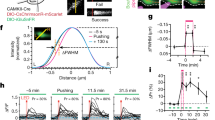Abstract
In sympathetic ganglia of the bullfrog, a slow synaptic potential lasting for minutes—the late slow excitatory postsynaptic potential (e.p.s.p.)—was discovered1. This slow response, unlike other previously known synaptic potentials in the autonomie nervous system, is not mediated by acetylcholine or monoamines. Similar non-cholinergic, non-adrenergic slow synaptic potentials have since been found in several other vertebrate autonomie ganglia2. We found that the late slow e.p.s.p. is probably mediated by a peptide that is identical to, or closely resembles, mammalian luteinizing hormone releasing hormone (LHRH)3, because (1) when applied directly to sympathetic neurones, LHRH and its agonists elicit a slow depolarization, associated with similar changes in membrane conductance and excitability as those occurring during the late slow e.p.s.p. Furthermore, both peptide-induced and nerve-evoked responses are blocked by antagonists of LHRH; and (2) radioimmunoassays indicate that a chain of sympathetic ganglia contains 100–800 pg of a LHRH-like peptide. Its distribution among spinal nerves, the great reduction of this substance following denervation, and its release from ganglia following isotonic KCl treatment or nerve stimulation suggest that the LHRH-like material is contained in preganglionic nerve fibres. Here we report that immunohistochemical staining of sympathetic ganglia shows that LHRH-like immunoreactivity is indeed present in synaptic boutons. We also show that the two types of ganglion cells (B cells and C cells) receive strikingly different patterns of peptidergic innervation.
This is a preview of subscription content, access via your institution
Access options
Subscribe to this journal
Receive 51 print issues and online access
$199.00 per year
only $3.90 per issue
Buy this article
- Purchase on Springer Link
- Instant access to full article PDF
Prices may be subject to local taxes which are calculated during checkout
Similar content being viewed by others
References
Nishi, S. & Koketsu, K. J. Neurophysiol. 31, 109–121 (1968).
Burnstock, G. & Hökfelt, T. Neurosci. Res. Prog. Bull. 17, No. 3, 379–519 (MIT Press, Cambridge, Massachusetts, 1979).
Jan, Y. N., Jan, L. Y. & Kuffler, S. W. Proc. natn. Acad. Sci. U.S.A. 76, 1501–1505 (1979); 77, 5008–5012 (1980).
Sternberger, L. A., Hardy, P. H., Cuculus, J. J. & Meyer, H. G. J. Histochem. Cytochem. 18, 315–333 (1970).
Nishi, S., Soeda, H. & Koketsu, K. J. Cell comp. Physiol. 66, 19–32 (1965).
Libet, B. & Kobayashi, H. J. Neurophysiol. 8, 805–814 (1974).
Hökfelt, T. et al. Nature 284, 515–521 (1980).
Jan, Y. N. & Jan, L. Y. (in preparation).
Author information
Authors and Affiliations
Rights and permissions
About this article
Cite this article
Jan, L., Jan, Y. & Brownfield, M. Peptidergic transmitters in synaptic boutons of sympathetic ganglia. Nature 288, 380–382 (1980). https://doi.org/10.1038/288380a0
Received:
Accepted:
Issue Date:
DOI: https://doi.org/10.1038/288380a0
This article is cited by
-
Multiple functions of non-hypophysiotropic gonadotropin releasing hormone neurons in vertebrates
Zoological Letters (2019)
-
Reinnervation of frog sympathetic ganglia after selective denervation of B or C neurons
Journal of Neurocytology (1996)
-
Functional organization of cotransmission systems: Lessons from small nervous systems
Invertebrate Neuroscience (1995)
-
NPY- and CGRP-like immunoreactive nerve fibers in the testis and mesorchium of the toad (Bufo arenarum)
Cell & Tissue Research (1995)
-
Peripheral projections of nervus terminalis LHRH-containing neurons in the tiger salamander, Ambystoma tigrinum
Cell and Tissue Research (1993)
Comments
By submitting a comment you agree to abide by our Terms and Community Guidelines. If you find something abusive or that does not comply with our terms or guidelines please flag it as inappropriate.



